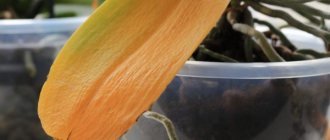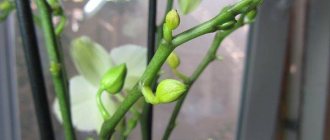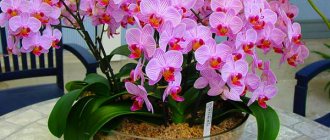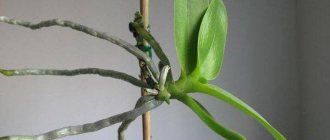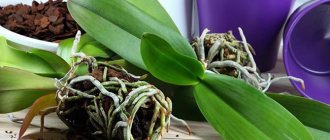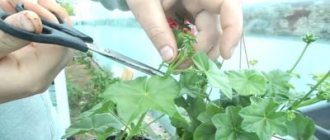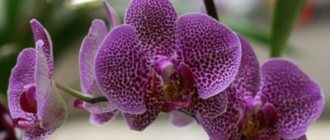Characteristics of the peduncle
A peduncle is a shoot of a plant on which buds, buds and seeds are formed. An orchid produces one shoot during the flowering period. With the help of an arrow, the flower reproduces.
The size of the shoot is from 10 to 30 cm. When the shoot reaches more than 10 cm, it should be tied up. The arrow should not be long. If the peduncle begins to grow more than 40 cm, the top is cut off by 2-3 mm.
The buds grow in the 2nd month from the beginning of the formation of the arrow.
The peduncle is responsible for flowering. In the process of growing an orchid, it is important to adhere to a number of rules so that the plant produces an arrow.
Care during the growth period of the peduncle
During the period of active growth, favorable conditions are created for the plant. Factors influencing growth include:
- Illumination. Little light will affect the development of the shoot.
- Watering. After the arrow begins to climb, the plant is watered as the soil dries out.
- Feeding. Feeding will help increase the number of buds. The orchid is fertilized before the first bud appears. Applying fertilizer after flowering has begun will cause the flowers to drop.
The flower cannot be replanted, as this causes stress. If the peduncle has stopped growing, it is cut off. The cut area should be treated with wood ash.
Damage to the peduncle
In the event of an arrow injury, the degree of damage is taken into account. If the shoot has been damaged superficially, it is treated with a mixture of ash and activated carbon, after which it should be strengthened with additional fixatives.
If the arrow is completely broken, the broken area is trimmed and treated with activated carbon. The shoot that breaks off is used for breeding.
Rest period
An interesting question: how long does an orchid rest after flowering? Orchids do not have a clearly defined dormant period , which means that the plant can develop equally successfully throughout the year, of course, under favorable conditions.
During the dormant period, favorable conditions must be created for the orchid.
But we can introduce the concept of “ conditional dormant period ” to highlight the time period when the plant gains strength, grows leaves and roots, in order to please us with its flowering in the future.
Orchid stimulation
Sometimes at home an orchid does not bloom for a long time. The reason for this is stable growth conditions.
In order for a home orchid to produce a peduncle, the plant is stimulated by stress. Stimulation is carried out in two ways - the drought method and temperature difference.
Drought method
Reducing watering causes the orchid to release a flower stalk. During the hot period, the flower is moistened 1 r. at 4 days, in cool weather – 1 r. in Week.
During this period, foliage is not sprayed. 10 days after reducing watering, the leaves of the plant become sluggish and the flower begins to shoot out an arrow. This method will force the orchid to produce buds again after a short break in flowering.
Temperature difference
In its natural environment, the orchid blooms in the spring, after cold weather. At home, it is important to create the same temperature.
To do this, the pot must be placed on a loggia or balcony. The temperature difference should be no more than 5 °C. This method will help to achieve flowering from an orchid that has been dormant for a long time.
Orchid propagation using a peduncle
Reproduction by peduncle is more effective than seeds
The cut arrow of the plant is used to grow a flower at home. This method is considered more effective than propagation by seeds. Propagation of an orchid using a peduncle is carried out in two ways.
Stem cuttings
This procedure is carried out in late spring or early summer. Cuttings are cut in this way:
- The lower leaves are cut off.
- Sections are sterilized with activated carbon.
- The plant is fertilized with nitrogen fertilizer.
- After the roots have formed on the cuttings, the shoot is cut off.
After cutting, the peduncle needs to be planted in prepared soil. The young orchid should not be watered for two days to allow the plant to take root. After 2-3 months the flower will begin to grow. It is important to ensure that the cutting does not break during cutting.
Growing in water
This method is used if the flower is frozen, sick, or the peduncle breaks off before flowering begins.
Sequence of procedure:
- The cutting is placed in a bottle, after cutting off the neck by 5 cm.
- The container is filled with water with the addition of activated carbon. The shoot should be 4-5 cm in water.
- The scales on the arrow are cut off with a razor to awaken the bud
- The cut site is treated with cytokinin ointment.
If the shoot is broken, then the place where it was broken is cut off. The ointment is applied every week for a month. The liquid in the bottle is changed once a week. After 3 weeks, the plant has a developed root system and can be planted in a pot.
Pruning the peduncle
After the buds fall off, the old shoot is cut off to put the orchid into a dormant state. The plant is capable of shedding its peduncle, but the sooner the arrow is removed, the faster the orchid will bloom again. A frozen shoot will consume the sap of the plant, which is why the orchid will not bloom again.
Pruning is carried out 3-4 days after flowering ends. There are several rules for the procedure:
- For work, a sharp garden pruner is used, which is disinfected with alcohol.
- After pruning, a short shoot should remain, about 2-3 cm.
- The cut area is dried with cotton wool and treated with activated carbon.
Sometimes the shoot does not stop growing after the flowers fall. After some time, new buds form on such an arrow.
On such a shoot, children with roots and buds can also form. They are used for growing orchids by cuttings.
How to care for an orchid after flowering?
In order for a plant to regularly delight its owner with beautiful buds, it is necessary not only to care for the orchid during flowering, but also to fully provide the flower with attention after this wonderful process is completed.
After the plant has flowered, its peduncle, on which the buds were placed, will remain completely “naked” and may begin to dry out. It is recommended to remove the unnecessary component, since it will no longer be useful to the flower and can create many problems.
Important! When it dries, a hollow space is formed at the tip of the peduncle into which water can enter. Moisture accumulated inside a hollow stem can cause the plant to rot. To prevent this from happening, the hole can be closed using beeswax.
If, after dropping the flowers, the peduncle remains juicy and green, it is better not to touch it. It is possible that after a certain time buds will appear on it again.
You can also provoke another flowering by cutting the peduncle above the third node. This action causes the plant to resume flowering after a couple of months. A separate article described in more detail what to do with the orchid after it has bloomed.
Reasons for the absence of a peduncle
The conditions for keeping an orchid depend on the variety and age of the plant. However, there are general care requirements, failure to comply with which will lead to a deterioration in the vital indicators of the flower. It is important to understand why the plant is unable to shoot an arrow.
Humidity level
Humidity level affects the appearance of flower stalks
Orchids grow in low humidity, but too dry air will prevent the plant from forming a flower stalk. Due to lack of moisture, the buds may fall off without opening. The humidity level depends on the orchid variety:
- Vanda flowering occurs when there is 70-80% moisture in the air during the day and 60% at night;
- Dendrobiums and Phlenopsis require 30-40% humidity;
- Cattleyas produce flower stalks at 40-50% humidity.
Air humidity is reduced by stimulating the flower using temperature changes. Otherwise, the root system will freeze and the plant will die.
Indoor light
Daylight hours for Phalaenopsis and Dendrobium should be at least 8 hours. In winter, the plant requires additional light sources. Special phytolamps are used for illumination. The amount of light required depends on the plant variety:
- Cymbidium produces a flower stalk under 12-hour light;
- Paphiopedilum requires light for 14 hours;
- Cattleyas grow with 12 hours of daylight.
Lack of lighting affects not only the plant’s ability to form a shoot. Without the right amount of light, the arrow will appear, but the plant will not bloom.
Watering mode
The arrow appears after stimulating the plant using the drought method. But, being without water for a long time, the flower will die. Orchids without moisture shed their arrows, saving water in the foliage and roots. Watering of phalaenopsis and dendrobium is carried out by spraying 1 r. in Week. For sympodial varieties, one spray every 10 days is enough. These include:
- Maxillaria;
- Ludisia;
- Vandu.
Temperature
Temperature is one of the main factors influencing the appearance of the arrow. The temperature difference method is the main way to stimulate an orchid. However, at low temperatures the flower sheds its peduncle. The heat level depends on the variety:
- Phalaenopsis will not form an arrow if the room temperature is below 16 °C;
- Dendrobium dies at temperatures below 14 °C;
- Cattleya and Wanda can withstand differences of up to 10 °C, but the room temperature should be above 12 °C.
How to make a phalaenopsis orchid bloom at home?
Let's talk about how to stimulate flowering using various methods.
Primary
Do not change location during budding period
Changes in lighting have a negative effect on the orchid. The plant has to rebuild the cellular structure of tissues, adapt previously poorly illuminated parts to intensive photosynthesis.
The resources necessary for flowering remain scarce, and flowering will be delayed until better times.
If you constantly twist and rearrange the pot, you may not wait for this joyful event
Special attention should be paid to seasonal changes in natural light
Transparent pot
Orchids are unique plants that have aerial roots. These shoots have the ability to absorb moisture directly from the air, despite their thick, gangly appearance.
The main distinctive ability of such roots is that they participate in photosynthesis in the same way as leaves, and it’s not for nothing that they are the same color.
Of course, stores now offer such an assortment of flower pots in all the colors of the rainbow that it’s a shame to plant an orchid in an unremarkable transparent container. But that’s exactly what she needs!
The best pot for phalaenopsis is transparent.
Attention! If plants of other families receive nutrients only from the leaves, then this unique plant among flowers produces chlorophyll literally with its entire body. An opaque pot will immediately deprive the orchid of half its nutrients.
Additional lighting in autumn-winter period
In winter, overcooling should be avoided, so a cold windowsill is not the best place for a delicate plant. A stand is needed so that there is an air gap between the cold surface and the roots of the plant.
For optimal lighting, it is rational to use economical LED phytolamps, which will provide plant cells with light of the red and blue spectrum. This is the light that is best suited for photosynthesis.
Day and night temperature difference (as in nature)
In tropical forest conditions, the difference between day and night temperatures is about 5 degrees Celsius. It is precisely this difference that can provoke the beginning of the growth of peduncles in phalaenopsis.
Repeatedly
The use of chemicals for stimulation
succinic acid
Succinic acid gently revitalizes the entire plant and is safe even in case of overdose:
- Prepare a solution based on 500 ml. clean water and 1 tablet of succinic acid (or the amount on the tip of a knife, if in powder);
- Spray the plant completely and water with the rest.
After treatment, the phalaenopsis will begin to produce new leaves and roots, take root and begin to bloom.
Succinic acid heals phalaenopsis.
Epin
This remedy helps the plant cope with stress and adapt to new conditions.
The leaves are sprayed with this preparation, but not watered.
Stimulating dormant kidneys with cytokinin paste
A powerful method of influencing dormant kidneys. The essence lies in the action of the phytohormone cytokinin, which helps not only to awaken the bud, but also to grow from it a healthy, strong peduncle with many buds.
Cold and hot shower
A contrast shower imitates tropical rains and also removes impurities from the surface of the plant. If there are spider mites on the leaves, the flow of water will wash them away.
A contrast shower will help stimulate flowering.
Carefully! If the water temperature is above 35 degrees Celsius, you can burn the plant. In general, this is a fairly harmless method for a healthy plant, but during the budding phase it can cause significant harm, because even turning the pot is not recommended.
Pests and diseases
A sick plant is not able to form an arrow. Among the main diseases affecting the peduncle are:
- Powdery mildew. The drug Skor or a solution of colloidal sulfur is used as treatment.
- Gray rot. A fungicide will help in the fight against it.
- Anthracnose. The disease is treated with the drugs Ritomil and Mikasan.
Pests can also cause the lack of arrows. Common harmful insects are:
- Mealybug. The affected plant is treated with a soap solution.
- Shield. Actellik solution is used for treatment.
- Thrips. These insects are destroyed using the drug Fitoverm.

